英语作文教学课件.
- 格式:ppt
- 大小:1.46 MB
- 文档页数:24
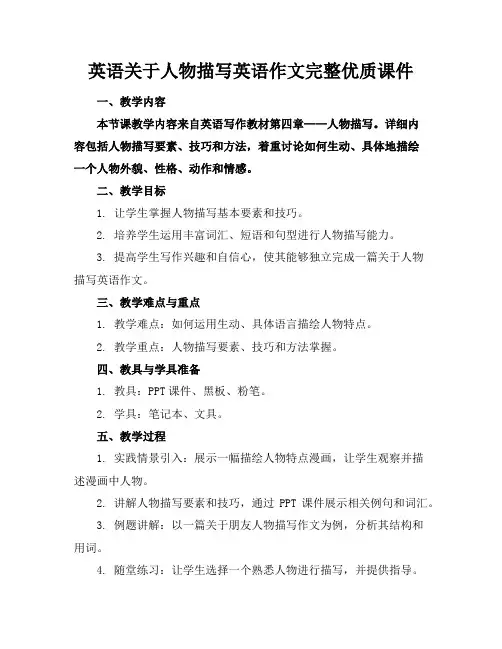
英语关于人物描写英语作文完整优质课件一、教学内容本节课教学内容来自英语写作教材第四章——人物描写。
详细内容包括人物描写要素、技巧和方法,着重讨论如何生动、具体地描绘一个人物外貌、性格、动作和情感。
二、教学目标1. 让学生掌握人物描写基本要素和技巧。
2. 培养学生运用丰富词汇、短语和句型进行人物描写能力。
3. 提高学生写作兴趣和自信心,使其能够独立完成一篇关于人物描写英语作文。
三、教学难点与重点1. 教学难点:如何运用生动、具体语言描绘人物特点。
2. 教学重点:人物描写要素、技巧和方法掌握。
四、教具与学具准备1. 教具:PPT课件、黑板、粉笔。
2. 学具:笔记本、文具。
五、教学过程1. 实践情景引入:展示一幅描绘人物特点漫画,让学生观察并描述漫画中人物。
2. 讲解人物描写要素和技巧,通过PPT课件展示相关例句和词汇。
3. 例题讲解:以一篇关于朋友人物描写作文为例,分析其结构和用词。
4. 随堂练习:让学生选择一个熟悉人物进行描写,并提供指导。
5. 小组讨论:学生分组讨论,互相评价、修改作文。
六、板书设计1. 人物描写要素:外貌、性格、动作、情感。
2. 人物描写技巧:形容词、副词、比喻、夸张等。
3. 常用句型和词汇。
七、作业设计1. 作业题目:请以“我老师”为题,写一篇人物描写英语作文。
2. 答案:见附件。
八、课后反思及拓展延伸2. 拓展延伸:推荐学生阅读相关英文书籍和文章,积累更多关于人物描写词汇和句型。
通过本节课学习,希望学生能够掌握人物描写基本技巧,提高写作水平,为今后英语学习打下坚实基础。
重点和难点解析一、教学内容选择与安排我深知教学内容选择与安排是教学成功关键。
因此,我精心挑选教材第四章人物描写部分,并详细规划教学内容,确保涵盖人物描写外貌、性格、动作和情感等多个方面。
我认为,这一全面教学内容有助于学生构建完整知识体系。
二、教学难点突破1. 通过展示漫画和实际例句,引导学生观察和思考如何运用形容词、副词等修辞手法来描绘人物。


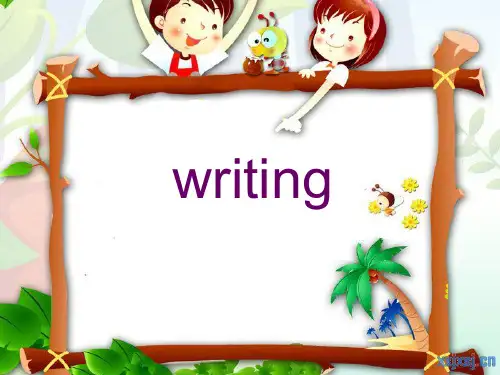


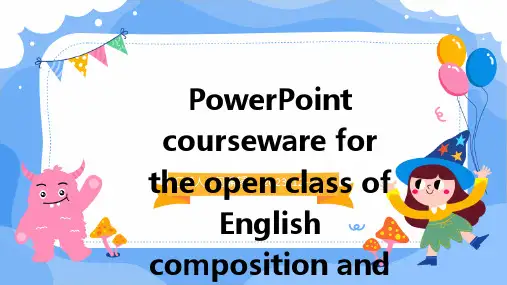

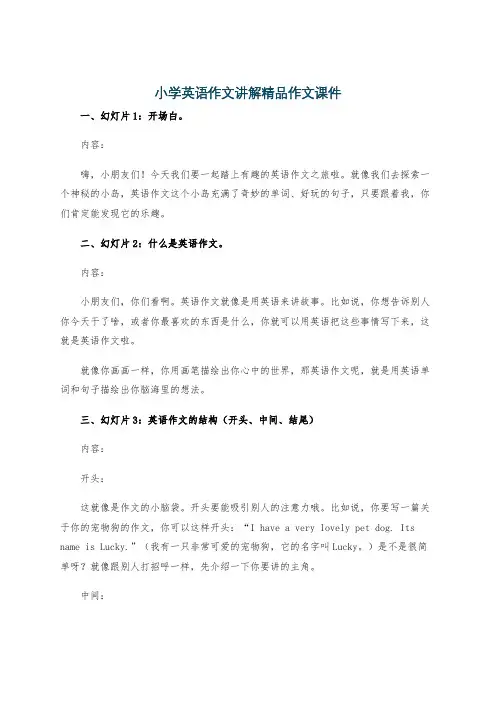
小学英语作文讲解精品作文课件一、幻灯片1:开场白。
内容:嗨,小朋友们!今天我们要一起踏上有趣的英语作文之旅啦。
就像我们去探索一个神秘的小岛,英语作文这个小岛充满了奇妙的单词、好玩的句子,只要跟着我,你们肯定能发现它的乐趣。
二、幻灯片2:什么是英语作文。
内容:小朋友们,你们看啊。
英语作文就像是用英语来讲故事。
比如说,你想告诉别人你今天干了啥,或者你最喜欢的东西是什么,你就可以用英语把这些事情写下来,这就是英语作文啦。
就像你画画一样,你用画笔描绘出你心中的世界,那英语作文呢,就是用英语单词和句子描绘出你脑海里的想法。
三、幻灯片3:英语作文的结构(开头、中间、结尾)内容:开头:这就像是作文的小脑袋。
开头要能吸引别人的注意力哦。
比如说,你要写一篇关于你的宠物狗的作文,你可以这样开头:“I have a very lovely pet dog. Its name is Lucky.”(我有一只非常可爱的宠物狗,它的名字叫Lucky。
)是不是很简单呀?就像跟别人打招呼一样,先介绍一下你要讲的主角。
中间:这是作文的身体部分。
在中间呢,你要把关于这个主角的事情详细地说出来。
还是说小狗Lucky,你可以写它长什么样子呀,“Lucky is white with black spots. It has two big eyes and a small nose.”(Lucky是白色的,带有黑色的斑点。
它有两只大眼睛和一个小鼻子。
)还可以写它喜欢做什么,“It likes running in the park and playing with its ball.”(它喜欢在公园跑,还喜欢玩它的球。
)结尾:结尾就像是作文的小脚丫啦。
结尾要让别人感觉这个故事讲完了,很完整。
你可以这样写,“I love my dog Lucky very much. It is my best friend.”(我非常爱我的狗Lucky,它是我最好的朋友。

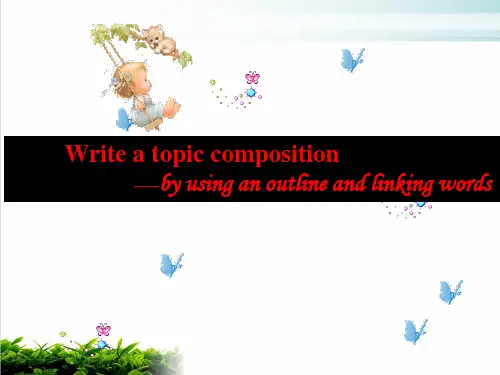
英语关于人物描写的英语作文完整精品课件一、教学内容本节课选自英语写作教材第四单元“人物描写”章节。
详细内容包括人物描写的要素、写作技巧、常见句型和词汇积累。
重点学习如何生动形象地描述人物的外貌、性格、动作和情感。
二、教学目标1. 掌握人物描写的要素和技巧,能独立完成一篇关于人物描写的英语作文。
2. 学会使用常见句型和词汇描述人物,提高英语表达能力。
3. 培养观察力和想象力,提高写作兴趣。
三、教学难点与重点难点:如何运用恰当的词汇和句型进行人物描写,使作文更具生动性和表现力。
重点:人物描写的要素和技巧,常见句型和词汇的运用。
四、教具与学具准备教具:PPT课件、黑板、粉笔学具:笔记本、练习本、词典五、教学过程1. 实践情景引入(5分钟)利用PPT展示一组人物图片,引导学生观察并描述图片中的人物,激发学生的学习兴趣。
2. 知识讲解(10分钟)讲解人物描写的要素(外貌、性格、动作、情感),介绍写作技巧,展示常见句型和词汇。
3. 例题讲解(15分钟)选取一篇优秀的人物描写作文,分析其结构和用词,引导学生学习并模仿。
4. 随堂练习(10分钟)根据所学内容,让学生尝试描写一个熟悉的人物,教师巡回指导,解答学生疑问。
5. 小组讨论与分享(5分钟)学生分成小组,互相交流描写的人物,选出最佳作品进行分享。
6. 作业布置(5分钟)布置一篇关于人物描写的英语作文,要求运用所学知识。
六、板书设计1. 人物描写要素:外貌、性格、动作、情感2. 常见句型和词汇3. 优秀作文示例七、作业设计1. 作业题目:Write an essay about a person you know well, describing his/her appearance, personality, actions and emotions.2. 答案要求:不少于100词,使用所学句型和词汇。
八、课后反思及拓展延伸1. 教学反思:关注学生在课堂上的参与程度,及时解答学生疑问,提高教学效果。
英文作文讲解ppt下载温馨提示:该文档是我店铺精心编制而成,希望大家下载以后,能够帮助大家解决实际的问题。
文档下载后可定制随意修改,请根据实际需要进行相应的调整和使用,谢谢!并且,本店铺为大家提供各种各样类型的实用资料,如教育随笔、日记赏析、句子摘抄、古诗大全、经典美文、话题作文、工作总结、词语解析、文案摘录、其他资料等等,如想了解不同资料格式和写法,敬请关注!Download tips: This document is carefully compiled by theeditor. I hope that after you download them,they can help yousolve practical problems. The document can be customized andmodified after downloading,please adjust and use it according toactual needs, thank you!In addition, our shop provides you with various types ofpractical materials,such as educational essays, diaryappreciation,sentence excerpts,ancient poems,classic articles,topic composition,work summary,word parsing,copyexcerpts,other materials and so on,want to know different data formats andwriting methods,please pay attention!Today, I'm going to talk about how to create an effective PowerPoint presentation. When it comes to making a good presentation, it's important to keep in mind that less is more. You don't want to overwhelm your audience with too much information on each slide. Instead, focus on key points and use visuals to support your message.One of the most important things to consider when creating a PowerPoint presentation is the design. You want to choose a clean and simple layout that is easy to read and visually appealing. Avoid using too many different fonts or colors, as this can be distracting. Stick to a consistent color scheme and font style throughout your presentation.In addition to the design, it's crucial to carefully plan out the content of your presentation. Start by outlining the main points you want to cover and then organize them into a logical sequence. Each slide shouldfocus on one main idea and include supporting points or visuals to reinforce your message.When it comes to delivering your presentation, it's important to practice beforehand. This will help you feel more confident and comfortable when speaking in front of an audience. Make sure to speak clearly and at a moderate pace, and try to engage your audience by asking questions or encouraging participation.Finally, don't forget to consider the technical aspects of your presentation. Make sure that your slides are easyto read and that any visuals or videos you use are high quality and work properly. It's also a good idea to have a backup plan in case of technical difficulties.In conclusion, creating an effective PowerPoint presentation requires careful planning and attention to detail. By focusing on design, content, delivery, and technical aspects, you can create a presentation that is engaging and impactful. Thank you for listening!。
初中英语作文写作课优秀课件目录CATALOGUE •Course Introduction andObjectives•Fundamentals of Writing•Writing skills and methods•Common Theme WritingGuidelines•Appreciation and Analysis ofMasterpieces•Writing training andimprovement01CATALOGUECourse Introduction andObjectivesThe Importance of Middle School English Composition•Improving students' comprehensive English proficiency: Throughwriting training, students can better grasp language elements such asvocabulary, grammar, and sentence structures, and improve theiroverall English proficiency.•Developing students' cross-cultural communication skills: Englishwriting is one of the important means of cross-culturalcommunication. Through writing training, students can betterunderstand the culture and thinking patterns of English speakingcountries, and improve their cross-cultural communication abilities.•To lay a foundation for students' future learning and work: GoodEnglish writing ability is an important foundation for students' futurelearning and work, which can provide more opportunities for theirfurther education and career development.Course objectives and requirementsKnowledge objectiveTo master the basic knowledge and skills of English writing, including writing process, article structure,paragraph development, sentence structure changes, etc.Ability objectiveTo independently complete an English article with clear structure, rigorous logic, and fluent language, andpossess certain critical thinking and innovative abilities.Emotional goalTo cultivate students' interest and enthusiasm for English writing, improve their self-learningability and collaborative spirit.Course arrangement and scheduleCourse arrangementThis course is divided into 10 class hours, each lasting 45 minutes. The coursecontent includes explanation of basic writing knowledge, analysis of sampleessays, writing practice, and homework review.Class timeOnce a week, the specific time will be arranged according to the student'sschedule and actual situation.Teaching methodAdopting a combination of online and offline methods, providing coursewareand teaching videos online, and conducting face-to-face tutoring and Q&Aoffline.02CATALOGUE Fundamentals of WritingVocabulary accumulation and application•Positive vocabulary and negative vocabulary: Positive vocabulary refersto words that can directly express the author's intention in the article,while negative vocabulary refers to words that cannot directly expressthe intention but can increase the richness and readability of thearticle.•Semantic analysis and accurate word usage: In English, many wordshave similar meanings, but their usage scenarios and contexts aredifferent. Therefore, when writing, it is important to pay attention toword meaning analysis and choose the most accurate vocabulary toexpress one's thoughts.•Phrases and idioms: There are many fixed phrases and idioms inEnglish, and mastering these expressions can make the article moreauthentic and natural.Sentence Structure and Changes•Simple sentences, compound sentences, and compound sentences:Simple sentences only contain one subject and one predicate; Parallelsentences are composed of two or more simple sentences connectedby parallel conjunctions; A compound sentence contains a main clauseand one or more subordinate clauses.•Sentence pattern transformation and expansion: Through sentencepattern transformation, declarative sentences can be transformed intointerrogative sentences, exclamation sentences, etc., increasing thediversity and expressive power of the article. At the same time,sentence components can also be expanded, such as addingattributives, adverbials, etc., to make the sentence more specific andvivid.There are multiple tenses and voices in English, and using them correctly can make the article more accurate and fluent.The subject and predicate mustbe consistent in person andnumber, otherwise it will lead togrammar errors.Articles, pronouns, andprepositions play importantconnecting roles in English. Usingthese vocabulary correctly canmake the article more coherentand clear. Meanwhile, it is alsoimportant to avoid commonusage errors.Tense and voice Subject verbconsistency Articles, pronouns, and prepositionsGrammar rules and common errors03CATALOGUEWriting skills and methods03Conceptual contentBased on the theme, develop associations, and conceptualize the content and key points of the article.01Carefully review the questioncarefully read the question, understand its meaning, and clarify the writing requirements and limitations.02Determine the themeBased on the requirements of the title, determine the theme and central idea of the article.Topic review and conceptionArticle structure and layoutReasonably arrange paragraphs01Based on the content of the article, arrange paragraphsreasonably to make the article clear in hierarchy.Highlight topic sentences02Set topic sentences at the beginning or end of each paragraphto clarify the central idea of the paragraph.Pay attention to transitions03Use transitional words or phrases between paragraphs to makethe article coherent and natural.Language expression and rhetoric•Accurate wording: Choose appropriate vocabulary to express ideasand avoid using obscure or overly simple words.•Diverse sentence structures: Use different sentence structures toexpress ideas, such as simple sentences, compound sentences, etc., toenhance the expressive power of the article.•Using rhetoric: Use appropriate rhetorical devices such as metaphors,personification, and parallelism to make the article more vivid andvivid.•Pay attention to grammar and spelling: avoid grammar and spellingerrors, and maintain the accuracy and standardization of the article.04CATALOGUE Common Theme WritingGuidelinesNarrative Writing•Select a theme and plot: Choose an interesting story theme and planthe plot development, including the cause, process, and outcome.•Shaping character images: By describing the appearance, personality,behavior, and other aspects of characters, vivid character images arecreated.•Pay attention to detail description: Use vivid details to help readersbetter understand and feel the story context.•Reasonable arrangement of narrative sequence: Different narrativemethods such as sequential, reverse, or interlude can be used to makethe story more engaging.Choose a familiar objectof explanation, such as an object, event,phenomenon, etc., and provide a detailedintroduction and explanation.Clearlyexplain the objectCollect and explain information andinformation related to the target through channels such as books and theinternet.Collect relevant informationOrganize the content ofthe article in an organized manner according to differentexplanation orders suchas time order, spatial order, or logical order.Arrange explanation orderUsing different methodssuch as definition,classification, comparison, and examples to make the article moreaccessible and understandable.Usingexplanatory methodsExpository writingargumentative writing•Identify arguments and evidence: Choose a controversial topic, clarifyyour viewpoint and stance, and prepare supporting evidence tosupport the argument.•Reasonable arrangement of argumentation structure: Differentargumentation structures such as total score, listing themes, andfinding several parallel viewpoints to discuss the themes can be usedto make the article clear and organized.•Using argumentation methods: using different argumentationmethods such as factual argumentation, rational argumentation, andcomparative argumentation to enhance the persuasiveness of thearticle.•Pay attention to language use: Use accurate and concise language toexpress opinions, and avoid using words that are too absolute orvague.05CATALOGUE Appreciation and Analysis of MasterpiecesExhibition of excellent works by studentsWork 1"My Favorite Teacher"Work 2A Memorable DayWork 3"The Power of Friendship"Teacher comments and suggestions•Comment on work one: The article has a clear structure and fluentlanguage, showcasing the excellent qualities of the teacher throughspecific examples, expressing the author's love and gratitude towardsthe teacher. Suggest adding some detailed descriptions to make thecharacter image more vivid.•Commentary on Work 2: The article features novel material selectionand vivid narration, showcasing the author's love and optimisticattitude towards life by recounting interesting events that happenedduring the day. Suggest refining the language expression to enhancethe infectiousness of the article.•Comment on work three: The article has a profound meaning and clearviewpoint. By discussing the power of friendship, it expresses theauthor's appreciation and admiration for friendship. It is suggested toadd some specific examples during the argumentation process tomake the viewpoint more convincing.Interactive session: Student self-evaluation and peer evaluation•Self evaluation: I believe that I have a certain foundation in writing andcan express my thoughts fluently. But there is still room forimprovement in the selection of materials and ideas, and moreattention needs to be paid to observing and thinking about life.•Mutual evaluation one: I think his works have concise language andclear expression, but there are still shortcomings in detail descriptionand emotional expression. I hope he can pay more attention to detailsand emotional presentation in his writing.•Mutual evaluation two: I think her works have novel material selectionand unique perspectives, but in the process of argumentation, thereare some that are too simplistic and one-sided. I hope she can addsome specific examples and data support in the argument to make theviewpoint more convincing.06CATALOGUE Writing training and improvementClassroom timed writing exercisesStrictly set the timein a simulated exam environment, students are required to complete theiressays within the specified time.Diversity of topic selectionProvide different types of questions to expose students to and practice variousgenres and themes.On the spot reviewProvide real-time feedback on students' compositions, pointing out theirstrengths and weaknesses, and providing suggestions for improvement.Suggestions for independent training after classPersist in writingEncourage students to develop the habit of writingevery day, such as writing diaries, weekly notes, oressays.Expand readingRecommend English original works or articlessuitable for middle school students to read, broadentheir horizons, and accumulate materials.Reflection and revisionGuide students to reflect and revise their owncompositions, and improve their self correctionability.RegularassessmentConduct a formal writing assessment at regular intervals to assess students' learning outcomes.PersonalizedfeedbackProvide specific feedback andsuggestions for each student'sessay to help them identify theirshortcomings.Display andCommunicationSelect excellent compositions fordisplay and communication,allowing students to learn fromeach other and progress together.010203 Regular evaluation and feedbackTHANKS感谢观看。